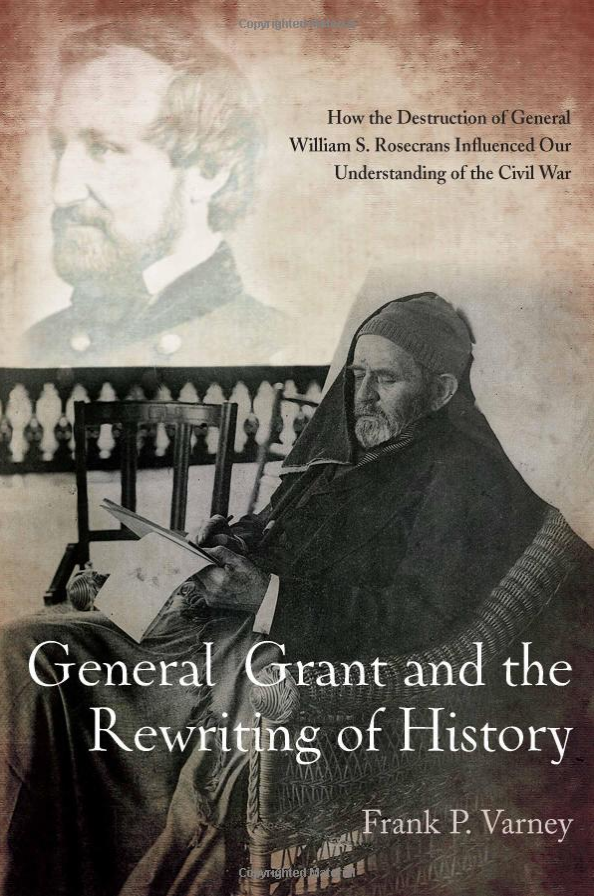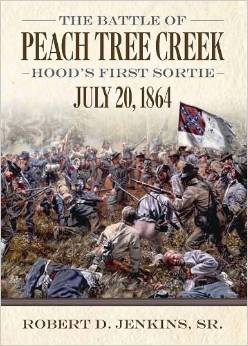General Grant and the Rewriting of History: How the Destruction of William S. Rosecrans Influenced Our Understanding of the Civil War by Frank P. Varney. Savas Beatie, 2013. Cloth, IBSN: 1611211182. $32.95.
 In General Grant and the Rewriting of History: How the Destruction of William S. Rosecrans Influenced Our Understanding of the Civil War, Frank Varney challenges Ulysses Grant’s widely read Personal Memoirs, especially as they pertain to the wartime performance of Union General William Rosecrans. Varney, an assistant professor of history at Dickinson State University in North Dakota, questions long-held beliefs regarding events involving Grant and Rosecrans in the all-important western theater. While Varney covers a lot of ground in this first volume of a projected two-volume series, the central theme is his contention that, given Grant’s propensity “to make himself look better and blame his errors on others”—coupled with the unwillingness of many historians to challenge “Grant’s veracity”—the general’s flawed version of events has distorted the nation’s understanding of America’s defining conflict (x-xi).
In General Grant and the Rewriting of History: How the Destruction of William S. Rosecrans Influenced Our Understanding of the Civil War, Frank Varney challenges Ulysses Grant’s widely read Personal Memoirs, especially as they pertain to the wartime performance of Union General William Rosecrans. Varney, an assistant professor of history at Dickinson State University in North Dakota, questions long-held beliefs regarding events involving Grant and Rosecrans in the all-important western theater. While Varney covers a lot of ground in this first volume of a projected two-volume series, the central theme is his contention that, given Grant’s propensity “to make himself look better and blame his errors on others”—coupled with the unwillingness of many historians to challenge “Grant’s veracity”—the general’s flawed version of events has distorted the nation’s understanding of America’s defining conflict (x-xi).
Varney takes a number of well-known Civil War historians—Bruce Catton, Peter Cozzens, Shelby Foote, Lesley J. Gordon, Earl J. Hess, James McPherson, Allen Nevins, Brooks Simpson, and Steven Woodworth, just to name a few—to task for sometimes engaging in lazy scholarship. While some come in for more criticism than others, Varney calls each of them out for a variety of mistakes or errors in judgment, the most egregious of which is falling under the spell of Grant’s Memoirs when drawing conclusions regarding Grant’s successes and Rosecrans’ failures. While Varney’s allegations have some merit, the author’s claims often fall flat in light of his own missteps.
In arguing his thesis, Varney sometimes oversells his case and even dips into the realm of proposing outlandish conspiracy theories. For example, in his chapter on Chickamauga, Varney speculates that Secretary of War Edwin Stanton may have intentionally intercepted and withheld a message in the War Office that would have alerted Rosecrans to the arrival of Confederate reinforcements under General James Longstreet. Admitting that “this is purely conjectural,” Varney writes, “it is not beyond the realm of possibility that the secretary of war . . . was not above withholding information that would indirectly cost the lives of thousands of Union soldiers, if in so doing it would accomplish the defeat, and the ultimate removal, of a man he hated” (193-194). While Stanton could certainly be abrasive, to suggest that he willingly sacrificed the lives of Union soldiers and the fate of an army to destroy Rosecrans is preposterous.
Varney also indicates that Union General Thomas Wood unnecessarily moved his division out of position at Chickamauga, causing a large gap in the Union line that Longstreet would exploit to great effect, as a way of getting back at Rosecrans, who had recently “publicly upbraided him for moving too slowly” (199). Never mind that Wood was under orders from Rosecrans to move and had already been castigated at least once for sluggishness; according to Varney, he should have known better and ignored or questioned the orders. To top it off, Varney also alerts the reader that “at West Point, [Wood’s] roommate had been none other than Ulysses S. Grant” (200). Cue the conspiracy music.
In yet another example of the absurd, Varney suggests that during Rosecrans’ tenure in Missouri near the end of the war, he “may” have uncovered the plot to assassinate Abraham Lincoln, but was kept from alerting Washington because he refused to communicate through normal channels since he had “good reason to distrust” the men surrounding the president—Stanton and Grant among them (248-250). Once again, Varney closes with what comes across as another backhanded comment linking Grant to some greater conspiracy: “Ironically, Grant and his wife had been invited to join the Lincolns at Ford’s Theater on the night the assassination occurred, but had declined the presidential invitation” (250). For a historian committed to admonishing others for single-sourcing their arguments, it seems hypocritical of Varney to engage in such wild speculation about historical figures’ motives with little or no evidence to back it up.
Varney also commits his own bit of sloppy research in his quest to correct the historical record. In his chapter on Second Corinth, Varney takes issue with the contentions of Peter Cozzens and Steven Woodworth that Rosecrans lost his composure in the stress of battle. He points out that the two historians rely on an anecdote from a chaplain in the 50th Illinois to illustrate their point about Rosecrans’ breakdown, yet according to Varney, “neither . . . gives any source for it, and the 50th Illinois was not part of Rosecrans’s command: it was in Bolivar with [Union General Stephen] Hurlbut” (114). But both Cozzens and Woodworth do provide a source—a regimental history published by a veteran of the 50th Illinois. Also, the Official Records shows that the regiment was, in fact, engaged in the battle as part of Union General Thomas Davies’ Second Division and suffered 31 casualties, something that would be very difficult to explain if it was not present at Corinth [OR, 17:1:175]. Such an error on Varney’s part calls into question the validity of his other assertions, especially considering his accusations regarding other historians’ carelessness with the source material.
Aside from these significant criticisms of Varney’s work, he does successfully demonstrate that Grant’s Memoirs need to be treated with the same careful reading as other Civil War memoirs, that Grant and others did sometimes go out of their way to undercut Rosecrans’ accomplishments, and that historians have at times given Grant’s version of events a pass. Again, the central tenet of his book is compelling. Had he simply stuck to the source material, avoided speculating about implausible conspiracy theories, and double-checked his citations, Varney’s thesis would carry more weight.
Jason M. Frawley, Ph.D., teaches at the Northwest Campus of Tarrant County College in Fort Worth, Texas. Most recently, he is the author of a chapter on Port Gibson in Steven Woodworth and Charles Grear’s anthology, The Vicksburg Campaign (2013).
